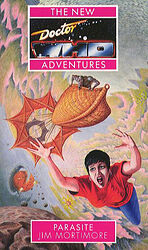
There are 3 reviews so far. To add a review of your own for this item, visit the voting page.
 |  |  |

 | Interesting and ingenious but convoluted |
|
 |  |  |
| By: | P. G. Steiner, Albuquerque, New Mexico, USA |
|
| Date: | Sunday 11 July 2004 |
|
| Rating: |    6 6 |
Parasite builds on events and characters that will be familiar to the readers of the author's earlier NA novel Lucifer Rising (written with Andy Lane). The Doctor, Ace and Benny arrive on Artifact, a vast, mysterious world that defies the laws of everyday physics. The Artifact is also undergoing cataclysimic changes, and our heroes must discover what is going on before they themsleves are destroyed in the ensuing chaos. Mortimer offers some tantalizing explanations for these mysterious goings-on drawing on both evolutionary biology and theoretical physics, which are puzzled out by Ace of all people. While some of the science fictional ideas in the novel are actually rather intriguing and ingenious, Mortimer goes overboard, putting one layer of complexity on top of another until the storyline becomes so convoluted that I gave up trying to follow it. I also found the idea of Ace--admittedly smart and resourceful woman, but hardly a great abstract scientific thinker--being the one to figure it all out and explain it to the reader more than a little hard to swallow.
| By: | David Turner, Buckinghamshire, UK , United Kingdom |
|
| Date: | Sunday 22 January 2017 |
|
| Rating: |    4 4 |
Parasite may have a creative setting. It's actually a very confusing, boring and nothing book
| By: | David Layton, Los Angeles, United States |
|
| Date: | Friday 25 October 2024 |
|
| Rating: |    7 7 |
With Parasite, Jim Mortimore decided to take Doctor Who into the giant, mysterious world genre of science fiction, like Larry Niven's Ringworld, Tony Rothman's The World Is Round, and Arthur C. Clarke's Rendezvous With Rama. The idea is that humans have discovered a mysterious planet or giant manufactured object, and some kind of investigative unit has been sent to explore it. In Parasite, that world is The Artifact, a planet seemingly turned inside out. The TARDIS crew have arrived here by accident, but of course just after some shenanigans have gone on with the investigative team. However, against the usual course of events, the TARDIS crew are not blamed for these shenanigans, but instead gradually get pulled into the attempts to discover what The Artifact is, and to discover what political double-dealing led to the deaths of the investigative team. However, all that gets sidelined to a large extent as the novel becomes a survival story, with The Doctor, Ace, and Benny separated and reunited several times. The Artifact is changing, going into a kind of self-destruct mode. On top of that, inside The Artifact, all species of flora and fauna go through impossibly rapid mutations into new species. This process of rapid speciation presents a threat as the life systems contaminate the people inside The Artifact. This is the ambitious part. Mortimore has made the strongest attempt in the New Adventures series of writing a hard science story for Doctor Who. There is no mysterious figure who is the "soul" of the world, no quasi-supernatural nonsense. Mortimore has tried to make it all work on scientific grounds. Part of the problem, though, is that his scientific knowledge, especially in biology, is not quite up to the task. That is not the worst problem, though. Another problem is that, as he conceives it, the inside-out world means that there are two surfaces, two locations that are "the ground," and so in between is a zero-gravity center where all the air is. The ground itself has only light gravity. That means that most of the action takes place floating, or more often flying, in zero-gravity. Mortimore repeatedly forgets this, and so has characters move and act as if they are on the ground. He will throw in little reminders that they are not, but mostly these do not compensate for the long stretches in which people floating or flying are having ordinary conversations, turning toward or away from each other in the normal sense, and so on. Plus, when characters are on the ground, Mortimore forgets that the gravity is low, so that they should be bouncing and bounding along. He has the characters walking through landscapes as if they were ordinary places on Earth. Also, Mortimore makes a quite pointless tie to one of his previous New Adventures novels. The Doctor is out of the action for three fourths of the novel. Mortimore returns to the earlier relations between the TARDIS characters where Ace openly despises The Doctor and distrusts Benny, and Benny has a lot of nothing to do. For me, the biggest problem is that Mortimore wants to batter these characters into oblivion, and still have them act and talk as if they have only little cuts and bruises. Benny is knocked unconscious at least four times. Ace has critters living inside her skin that burst out, she has her eyes gouged out, and suffers several more physical indignities. Benny undergoes impromptu surgery twice, both by people with no medical training. One time, it involves drilling a hole in her head, and another it involves injecting her with poison, and then surgically removing a parasitical creature. How she survives either of these tortures (the second by Ace), and revives to quip away with ironic witticisms like the Benny of old is beyond my understanding. Given what Mortimore puts them through, the entire TARDIS crew should have been dead halfway into the book. It seems to me that all my complaints about the first two years of New Adventures books really come down to failures of editing. These are all problems that the editors could and should have fixed.


